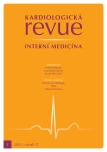Direct oral anticoagulants – perspectives of therapeutic drug monitoring
Authors:
K. Urbánek
Authors‘ workplace:
Ústav farmakologie, LF UP a FN Olomouc
Published in:
Kardiol Rev Int Med 2015, 17(1): 76-81
Category:
Internal Medicine
Overview
Direct oral anticoagulants (DOACs) are agents that have recently been introduced into clinical practice to replace warfarin. In addition to improved efficacy and safety, one of the anticipated benefits was the absence of the need for regular monitoring of coagulation parameters with the necessity of adjusting the doses on the basis of the obtained results. However, increasing need for quantitative determination of these substances in plasma in specific cases has been found. The gold standard for the essay of DOACs’ plasma concentrations is the LC‑ MS method. In daily practice, the use of indirect methods such as dTT for inhibitors of thrombin and chromogenic determination of anti‑Xa for factor Xa inhibitors is more usual. So far, it has not been recommended for any DOAC that therapeutic drug monitoring should be performed repeatedly for dosage adjustment. Plasma concentrations measurements are used in cases such as suspected noncompliance, bleeding complications during treatment, the need for acute thrombolysis or surgical procedures.
Keywords:
direct oral anticoagulants – therapeutic drug monitoring – dabigatran – rivaroxaban – apixaban
Sources
1. Levy JH, Spyropoulos AC, Samama CM et al. Direct oral anticoagulants: new drugs and new concepts. JACC Cardiovasc Interv 2014; 7: 1333– 1351. doi: 10.1016/ j.jcin.2014.06.014.
2. Harder S, Graff J. Novel oral anticoagulants: clinical pharmacology, indications and practical considerations. Eur J Clin Pharmacol 2013; 69: 1617– 1633. doi: 10.1007/ s00228‑ 013‑ 1510‑ z.
3. Schmitz EM, Boonen K, van den Heuvel DJ et al. Determination of dabigatran, rivaroxaban and apixaban by ultra‑ performance liquid chromatography – tandem mass spectrometry (UPLC‑ MS/ MS) and coagulation assays for therapy monitoring of novel direct oral anticoagulants. J Thromb Haemost 2014; 12: 1636– 1646. doi: 10.1111/ jth.12702.
4. Gous T, Couchman L, Patel JP et al. Measurement of the direct oral anticoagulants apixaban, dabigatran, edoxaban, and rivaroxaban in human plasma using turbulent flow liquid chromatography with high‑resolution mass spectrometry. Ther Drug Monit 2014; 36: 597– 605. doi: 10.1097/ FTD.0000000000000059.
5. Douxfils J, Dogné JM, Mullier F et al. Comparison of calibrated dilute thrombin time and aPTT tests with LC‑ MS/ MS for the therapeutic monitoring of patients treated with dabigatran etexilate. Thromb Haemost 2013; 110: 543– 549. doi: 10.1160/ TH13‑ 03‑ 0202.
6. Douxfils J, Tamigniau A, Chatelain B et al. Comparison of calibrated chromogenic anti‑Xa assay and PT tests with LC‑ MS/ MS for the therapeutic monitoring of patients treated with rivaroxaban. Thromb Haemost 2013; 110: 723– 731. doi: 10.1160/ TH13‑ 04‑ 0274.
7. Douxfils J, Chatelain C, Chatelain B et al. Impact of apixaban on routine and specific coagulation assays: a practical laboratory guide. Thromb Haemost 2013; 110: 283– 294. doi: 10.1160/ TH12‑ 12‑ 0898.
8. Gouin‑Thibault I, Flaujac C, Delavenne X et al. Assessment of apixaban plasma levels by laboratory tests: suitability of three anti‑Xa assays. A multicentre French GEHT study. Thromb Haemost 2014; 111: 240– 248. doi: 10.1160/ TH13‑ 06‑ 0470.
9. Mismetti P, Laporte S. New oral antithrombotics: a need for laboratory monitoring. For J Thromb Haemost 2010; 8: 621– 626. doi: 10.1111/ j.1538‑ 7836.2010.03764.x
10. Bounameaux H, Reber G. New oral antithrombotics: a need for laboratory monitoring. Against. J Thromb Haemost 2010; 8: 627– 630. doi: 10.1111/ j.1538‑ 7836.2010.03759.x.
11. Samama MM, Guinet C, Le Flem L. Do new oral anticoagulants require laboratory monitoring? The clinician point of view. Thromb Res 2012; 130 (Suppl 1): S88– S89. doi: 10.1016/ j.thromres.2012.08.286.
12. Lippi G, Favaloro EJ, Mattiuzzi C. Combined administration of antibiotics and direct oral anticoagulants: a renewed indication for laboratory monitoring? Semin Thromb Hemost 2014; 40: 756– 765. doi: 10.1055/ s‑ 0034‑ 1381233.
13. Wong PC, Crain EJ, Watson CA et al. Favorable therapeutic index of the direct factor Xa inhibitors, apixaban and rivaroxaban, compared with the thrombin inhibitor dabigatran in rabbits. J Thromb Haemost 2009; 7: 1313– 1320. doi: 10.1111/ j.1538‑ 7836.2009.03503.x.
14. Reilly PA, Lehr T, Haertter S et al. The effect of dabigatran plasma concentrations and patient characteristics on the frequency of ischemic stroke and major bleeding in atrial fibrillation patients: the RE‑ LY Trial (Randomized Evaluation of Long‑Term Anticoagulation Therapy). J Am Coll Cardiol 2014; 63: 321– 328. doi: 10.1016/ j.jacc.2013.07.104.
15. Charlton B, Redberg R. The trouble with dabigatran. BMJ 2014; 349: g4681. doi: 10.1136/ bmj.4681.
16. Moore TJ, Cohen MR, Mattison DR. Dabigatran, bleeding, and the regulators. BMJ 2014; 349: g4517. doi: 10.1136/ bmj.4517.
17. Cohen D. Concerns over data in key dabigatran trial. BMJ 2014; 349: g4747. doi: 10.1136/ bmj.g4747.
18. Cohen D. Dabigatran: how the drug company withheld important analyses. BMJ 2014; 349: g4670. doi: 10.1136/ bmj.670.
19. Skeppholm M, Hjemdahl P, Antovic JP et al. On the monitoring of dabigatran treatment in "real life" patients with atrial fibrillation. Thromb Res 2014; 134: 783– 789. doi: 10.1016/ j.thromres.2014.06.016.
20. Wannhoff A, Weiss KH, Schemmer P. Increased levels of rivaroxaban in patients after liver transplantation treated with cyclosporine A. Transplantation 2014; 98: e12– e13. doi: 10.1097/ TP.0000000000000223.
21. Mueck W, Stampfuss J, Kubitza D et al. Clinical pharmacokinetic and pharmacodynamic profile of rivaroxaban. Clin Pharmacokinet 2014; 53: 1– 16. doi: 10.1007/ s40262‑ 013‑ 0100‑ 7.
Labels
Paediatric cardiology Internal medicine Cardiac surgery CardiologyArticle was published in
Cardiology Review

2015 Issue 1
Most read in this issue
- TDM of digoxin in clinical practice
- Drug interaction and current clinical practice
- Cardiac resynchronization therapy – when should it be indicated and for whom?
- TDM of antibiotics in clinical practice
